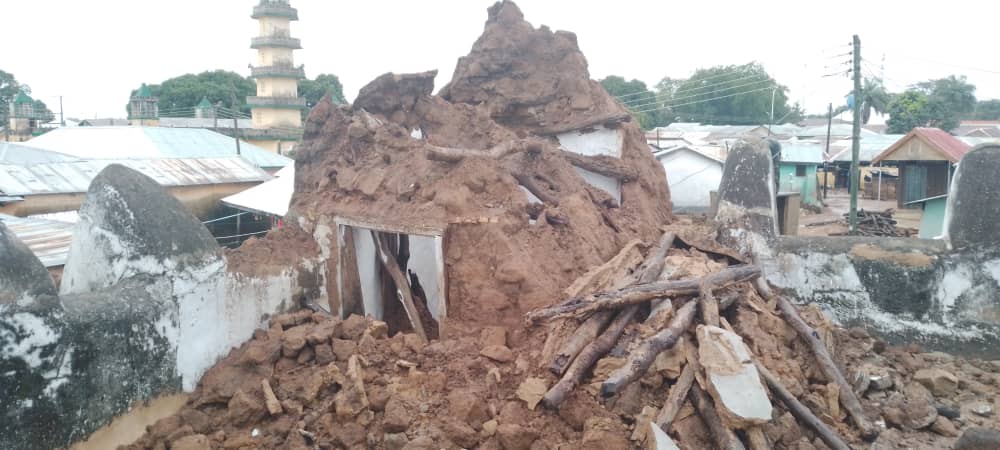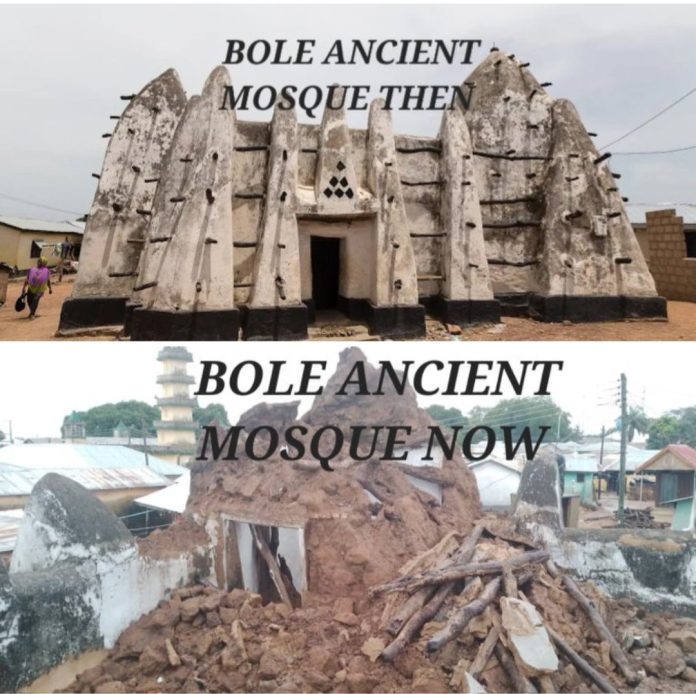The Chief Executive Officer (CEO) of the Northern Tourism and Cultural Forum Mr Mohammed Muniru Cosmos has said the partly collapse of the Bole Sudanese Style Mosque (estimated to be 400 years and Over) as a result of heavy rains on 17th September, 2023 is of concern to many individuals and organisations in the world and therefore appealed to the people of Bole not to destroy the Mosque completely as has happened in other similar Mosques in the area like the Dakurpe one.


Speaking to Bole based Nkilgi Fm, Mr Muniru who is also the Chief Executive Officer (CEO) of Ndewura Ndewura Travel & Tours, the National Vice Chairman of Tour Guides Association of Ghana and the Chairman of the Ghana Tourism Federation, Northern Region, Savannah & North East Branch pleaded with the the Paramount Chief of the Bole Traditional Area, the Bole Chief Imam and the Muslim Community especially residents of Nyimange to hold high the Mosque and shouldn’t do anything to pull it down since it is a heritage site that goes beyond Bole.
The renowned Tour Guide said a number of individuals and organisations are mobilising to come and help and that the concerns on the Mosque are coming from all over the world.
He further mentioned that a sub Chief of Bole traditional area Kanyepewura Solomon Tampuri who is a Cultural advocate based in the United Kingdom is aware of the situation of the Mosque and probably mobilising to come and help.
Mr Muniru said his interest in the Bole Ancient mosque has been very pronounced and that has visited the place late 2022 and early 2023 last year and took some pictures.
He said closely working with the Ghana Museums and Monuments Board (GMMB) and the United Nations Educational, Scientific and Cultural Organization (UNESCO), he has officially been tasked to make sure he is able to document historical monuments anywhere they are and the Bole Ancient mosque is not an exception.
Mohammed Muniru Cosmos said the Bole Sudanese Style mosque is a national heritage site and the organisations are thinking of listing it on the tentative list of the Ghana heritage list where the United Nations Educational, Scientific and Cultural Organisation will endorse it and thereby open it up for investors, well wishers, volunteers all over the world to come and probably support to fix it and open it up for a great tourist attraction in addition to the other Ancient Mosques at Larabanga, Maluwe, Banda -Nkwanta and Wa.
He said immediately the Bole Sudanese Style mosque collapsed and he heard news about that, he actually took a photo of it and sent it to the office of the Ghana Museums and Monuments Board (GMMB) and the Headquarters United Nations Educational, Scientific and Cultural Organisation (UNESCO) and has received many calls on the situation.
He disclosed that on the 20th September, 2023, he was supposed to come with the UNESCO Country Director Mr Abdul Rahman Diallo who was in Tamale for a programme but for the collapse of the Doli bridge near Bole, they couldn’t make the trip.
While the people of Bole in the Savannah Region from indications seem not to care about the partial collapse of the Bole Sudanese Style Mosque as a result of heavy rains in the area, many individuals and international organisations concerned about Ghana’s cultural and historical heritage have expressed their concern.
After the collapse of some parts of the mosque after heavy rains, an American multimedia specialist based in Ghana Mr William Haun wrote on his Twitter (now X) that;
“Ghana lost yet another historic & Cultural landmark due to neglect.
The ancient mud Mosque at Bole has collapsed.
Torrential rains are being blamed but 5 years ago I visited it & wrote an article documenting visible termite infestation in its rafters”.
William Haun after a visit to the Mosque in Bole in May, 2018 wrote;
“On my trip to see the ancient mosques in northern Ghana, I was disappointed to find two of the three mud mosques in the Upper West Region to be collapsed and abandoned. Entering the Northern Region (part which is now Savannah Region), my first stop was in ex-president John Mahama’s hometown of Bole where another Sudano-Sahelian style mosque was reported to stand.
William Haun added; “I was pleased to find it not only standing but still in use. I greeted the chief imam, signed the visitor register, paid my 10 cedis and was given a guide to take me in. I arrived a bit after noon time and they were preparing for midday prayers so my tour was a bit rushed.
William Haun further wrote; “One interesting feature of the ‘ancient’ Bole mud mosque is that the wooden poles that are found in and between the buttresses do not function as any sort of structural support to the building. They are used as scaffolding for times of maintaining the plaster and painting. However, they are mainly decorative features meant to maintain the West Sudanese aesthetic”.
He added; “A few modern improvements have been made to this building. The most egregious (in my opinion) is that in the last year or so they tiled the floor%.
The American citizen said; “I was disappointed to see that the local community has put their energy and finances into modern tiles but left other parts of the mosque in disrepair. The building could use a new whitewashing and the support beams in the ceiling were visibly infested with termites. Unless something is done to control the termites, I wouldn’t be surprised if the roof collapses in a year or two”.
The Bole Sudanese Style Mosque, with its grand domes and intricate minarets, has been a cherished landmark for centuries. Its majestic presence has not only provided a place of worship for the local Muslim community but has also attracted visitors from far and wide, marveling at its beauty and historical significance.
Source: nkilgifmonline.com




